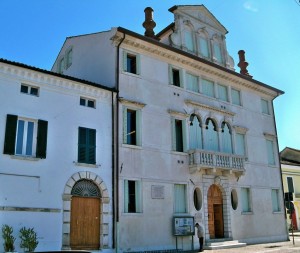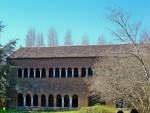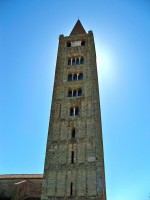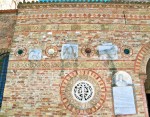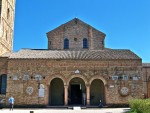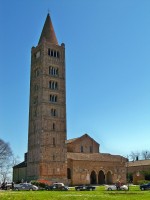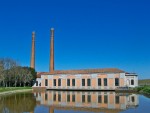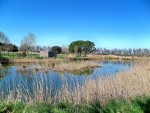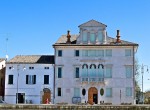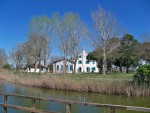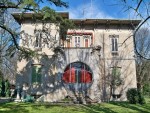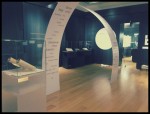Codigoro
Codigoro is an agricultural centre in the Ferrara Delta, which has acquired industrial importance especially in the field of processing and transformation of agricultural products. Its historical evolution is linked to the events of the Abbey of Pomposa and to the centuries-old reclamation work of this territory. Giorgio Bassani describes these places in his last novel “L 'airone” (The Heron).
1.Historical notes
The first evidence of a settlement in the Codigoro area dates back to Roman times, when the place was called Neronia or Neroma, probably because of the black and marshy land. The Roman road Popilia, which connected Rimini and Acquileia, passed through here.
In the 14th century the place changed its name to Codigoro da Caput Gauri: the town was in fact at the mouth of the Po di Goro. In the meantime, the area entered the sphere of influence of the Abbey of Pomposa, where a nucleus of Benedictine monks had been operating since the 7th-8th century, beginning the first reclamation works in the territory.
In 1224 the Abbot of Pomposa invested Azzo d'Este with the tenure of the Codigoro podestà. After a first reclamation project under the duchy of Borso d'Este in 1464, Alfonso II undertook a new reclamation campaign under the direction of Giambattista Aleotti between 1575 and 1580.
After the devolution of the Duchy of Ferrara to the Papal States in 1598, Codigoro became a centre for fishermen and hunters. It was only during the French period and then after the Unification of Italy, starting in 1870, that the reclamation work resumed: in this period the first water supply plant was built and about 56,000 hectares of land were drained.
Today Codigoro is a large agricultural centre within the Po Delta Park, and has acquired industrial importance, especially in the field of processing and transformation of agricultural products.
2.Palazzo del Vescovo (Bishop's Palace)
Located along the Po of Riviera Cavallotti, it was originally the seat of the abbot of Pomposa: the building has therefore been the administrative headquarters of the abbey possessions since about 1100.
The current appearance is the result of a radical reconstruction dating back to the early eighteenth century, which gave it a Venetian style, introduced by the noble family of Cestari di Chioggia, who later donated it to the bishop of Comacchio: hence the name Palazzo del Vescovo.
In the 1960s it was purchased by the Municipality of Codigoro and was renovated in 1975-1978. Today it is home to the Public Library and the Giorgio Bassani Foundation and a cultural centre.
3.Water supply system
It is one of the first buildings that we meet when arriving in Codigoro along the road that runs parallel from Ferrara along the Po di Volano. The waterworks date back to 1855 and were renovated and expanded in 1911 by the engineer Ciro Contini.
The system regulates the introduction of water from the former lagoons into the Volano: large hydraulic lifting pumps, originally steam-powered, lift the water from below sea level to enter the large collectors that resume the Este system route.
The complex consists of a long building containing the lifting pumps and two chimneys, all made of brick. It has a neoclassical architectural style with the perimeter pillars that become decorative pilasters defining the spaces for the extensive windows.
4.Abbey of Pomposa
The abbey, with its unmistakable Romanesque bell tower, is perhaps the most important religious building in terms of antiquity and artistic evidence of the Ferrara provincial territory.
The presence of a Benedictine monastery was noted for the first time at the end of the 9th century. It was the Ravenna abbot Guido degli Strambiati (1008-1046) who initiated the radical reform of the Pomposa buildings, enlarged and embellished during the 11th century: in 1026 the church was reconsecrated, in 1063 the bell tower was built and then the cloisters and the Palazzo della Ragione, in which the abbot of Pomposa exercised civil justice. In those years, the Abbey of Pomposa also hosted numerous famous people, including San Pier Damiani and Guido d 'Arezzo, who seems to have developed his method of writing musical notes right here.
With the route of the Po di Ficarolo, the plotted course of the Great River Delta changed profoundly and the process of embankment of these areas began. Over time, the abbey gradually lost its importance and in 1496 it was assigned as an annexe of the new monastery of San Benedetto founded in Ferrara by Cardinal Ippolito d 'Este.
In 1802, with the suppression of the Napoleonic age, the complex with its land was taken over by the state, which sold it to private individuals: the Guccioli marquises of Ravenna used the various buildings for agricultural use. Between 1910 and 1914, the Italian state expropriated a large part of the Pomposa buildings, carrying out a complete cycle of restorations between 1925 and 1930 that recovered the still existing buildings.
The Church of Santa Maria is accessed from a three-arch portico, richly decorated in terracotta and marble and with the inclusion of multicoloured majolica tiles, two particularly elegant circular windows closed by precious stone railings carved with phytomorphic figures and animals. The interior is divided into three naves by two rows of columns in the Ravenna-Byzantine style. The mosaic floor, built between the 6th and 12th centuries, is of great value. The fresco in the apse dates back to the 13th century and is the work of Vitale da Bologna. Along the side walls of the central nave there is a very rich decoration, also from the 13th century, arranged in three bands: the highest represents scenes from the Old Testament, the middle scenes from the New Testament and the lowest scenes from the Apocalypse of St. John. A large Last Judgement is depicted on the back wall.
To the side of the church is the 48-metre-high bell tower, erected in 1063 by the architect Deusdedit: divided into nine modules, each with increasingly wide and numerous windows from the bottom to the top. The red and yellow brick façade preserves inserts of ceramic basins (18 ancient, the others modern) with designs of trees, fish, birds and flowers: they can be dated to the 11th century and come from various Mediterranean countries, such as Egypt, Tunisia and Sicily.
The museum was set up definitively in 1976, and exhibits works of art of different nature and era, but mainly medieval, relating to the large convent building. Particularly interesting – in addition to pieces of detached frescoes from the various pictorial cycles of the church (10th and 14th centuries) – are capitals and architectural sculptures of reuse ranging from the 6th to 10th centuries.
5. Canneviè
Along the road that leads from the Statale Romea to Volano is the Biotopic station of Canneviè.
The current casone (hut), of great environmental value, was built in the 18th century as a fishing and fish pickling station. Radically renovated, the house currently has a two-storey body with an elongated rectangular plan: on the north façade there is a beautiful fireplace protruding at full height.
Near the casone we find the Palazzina di Canneviè: residence of the owner or of the fishing chief, from a later period, despite the 18th century lines of Venetian influence. The main body consists of two floors, with the central part raised one floor and ending with a simple triangular pediment. Two overhanging chimneys characterise the main façade.
6.Codigoro Heronry
It is an area of about 8 hectares inside the former Eridania sugar factory. Among the trees – False Acacias, Poplars, Elders – numerous nests of grey herons and great white egrets, little egrets and night herons have been built.
First recorded in 1981 by researchers at the University of Pavia, the Codigoro Heronry has been described as one of the largest and most important Heron colonies in northern Italy. For this reason, the Provincial Administration of Ferrara has established an Oasis for the Protection of Wildlife.
7.Quotes
"And soon, without ever falling below seventy, he arrived within view of the Abbey of Pomposa. How long he hadn't been in those parts! – he couldn't help but sigh as the Aprilia raced fast along the final straight. But he was happy: happy that the abbey, regardless of the much thicker vegetation that currently surrounded it (a sign that the waterworks of the Consorzio Bonifiche had been able to continue working undisturbed even in recent years), had gone through the war preserving its original appearance of a large farm like La Montina. Yes, he said to himself, staring at the red, ancient stones of the monastery. With that bell tower, on the one hand, capable as a grain silo; with that church in the middle that more than a church brought to mind a barn; with those other unadorned buildings, on the right, arranged like farmhouses around the courtyard: indeed, albeit larger, Pomposa resembled Montina in all respects ".
Giorgio Bassani, L’Airone, in Il romanzo di Ferrara, Book V, Milan, Mondadori, p. 59.
Sitography
Fototeca
Related Subjects
Related Themes
Compiling entity
- Istituto di Storia Contemporanea di Ferrara
Author
- Federica Pezzoli
- Sharon Reichel

